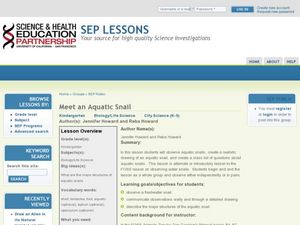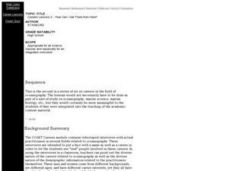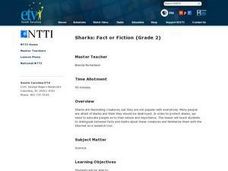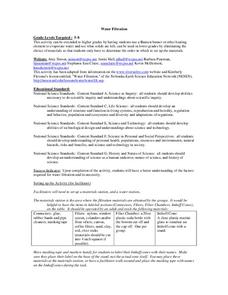Curated OER
Meet an Aquatic Snail
Students explore aquatic snails. In this life science lesson, students create a class list of questions about aquatic snails and begin to observe aquatic snails in the classroom. Students record observations.
Curated OER
Vegetable Twister
Second graders study the changes in organisms over time. In this Life Science lesson, 2nd graders explore how living things react to changes in the environment. Students identify the basic needs of living things.
Curated OER
How Smoking Affects Our Repiratory System
Seventh graders examine the dangers of smoking. In this life science lesson, 7th graders survey their schoolmates about the factors that would influence them to smoke. They present their findings in class by creating a presentation.
Curated OER
Life Traps - Lesson Plan
Students observe and discuss microbes. In this microbes lesson students complete a lab activity where they grow microbes in petri dishes and discuss their findings.
Curated OER
Sound for Sight
Learners study echolocation and understand how dolphins use it to locate prey, escape predators, and navigate their environment. They view a video, "In the Wild-Dolphins with Robin Williams" and see first hand how dolphins communicate. ...
Curated OER
Wetland Food Webs
Students study life science. In this food webs and food chains comparison instructional activity, students examine the wetlands to discover the relationships that exist between the animals that live there. They participate in group...
Curated OER
Round and Round-The Water Cycle
Students explore the water cycle. In this earth science instructional activity, students work in small groups to read various books on the water cycle and take notes on chart paper. Students share their notes and teach a younger audience...
Curated OER
Careers Lessons 2 - How Can I Get There from Here?
Students identify differences between jobs and careers, and identify career areas within the broad field of oceanography. They research, compare and contrast requirements needed to become a practitioner of various oceanographic career...
Curated OER
Sharks: Fact or Fiction
Second graders discover the truth about sharks. In this shark lesson, 2nd graders use different resources to help distinguish between fact and fiction with what they have heard about sharks. They complete an attached activity sheet.
Curated OER
Sibling Relationships in the Animal World
Students research sibling relationships in the animal world. In this animal science lesson, students read the book, Sisters and Brothers: Sibling Relationships in the Animal World and discuss the sibling relationships. Students choose an...
Curated OER
Design a Reef!
Young scholars explore coral reef ecosystems. In this ecosystems science instructional activity, students research coral reef ecosystems to determine the major functions the participating organisms must perform. Young...
Curated OER
Plant Identification: New Jersey vs. Ecuador
Sixth graders discover the different plants that grow in different climates through specimen collections. In this botany lesson, 6th graders examine plants from both New Jersey and Ecuador and discuss what conditions could create...
Curated OER
Modeling DNA Structure
Young scholars build their own DNA molecules using candy. In this science lesson, students build DNA molecules using licorice and gumdrops. The lesson includes the use of streaming videos from the teacher's domain.
Curated OER
Teaching about the Effect of pH on Aquatic Organisms
Students perform experiments to determine the PH, acidity, and buffering qualities of a lake that make them sensitive to acid deposition.
Curated OER
Water Filtration
Students investigate our water system and how it is filtered. In this science lesson, students perform a laboratory activity to investigate the process that goes into filtering water. They relate this activity to other subject areas...
Curated OER
Flesh Eating Bugs, Moldy Corpses, The Trail of a Killer
Learners read about how forensic entomologists use maggots to solve murders. In this forensic science lesson, students read an article and answer questions. They go to different websites about evidence and fingerprinting.















